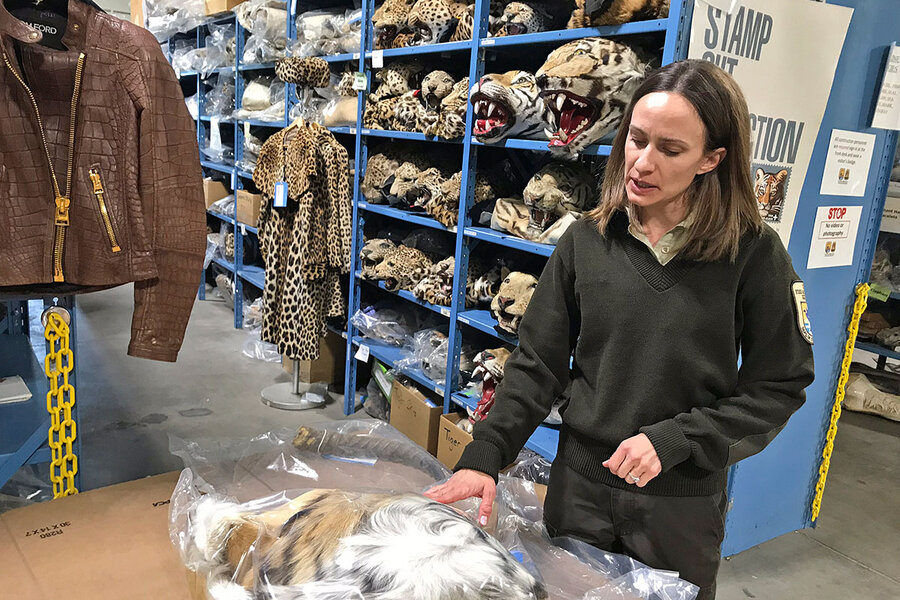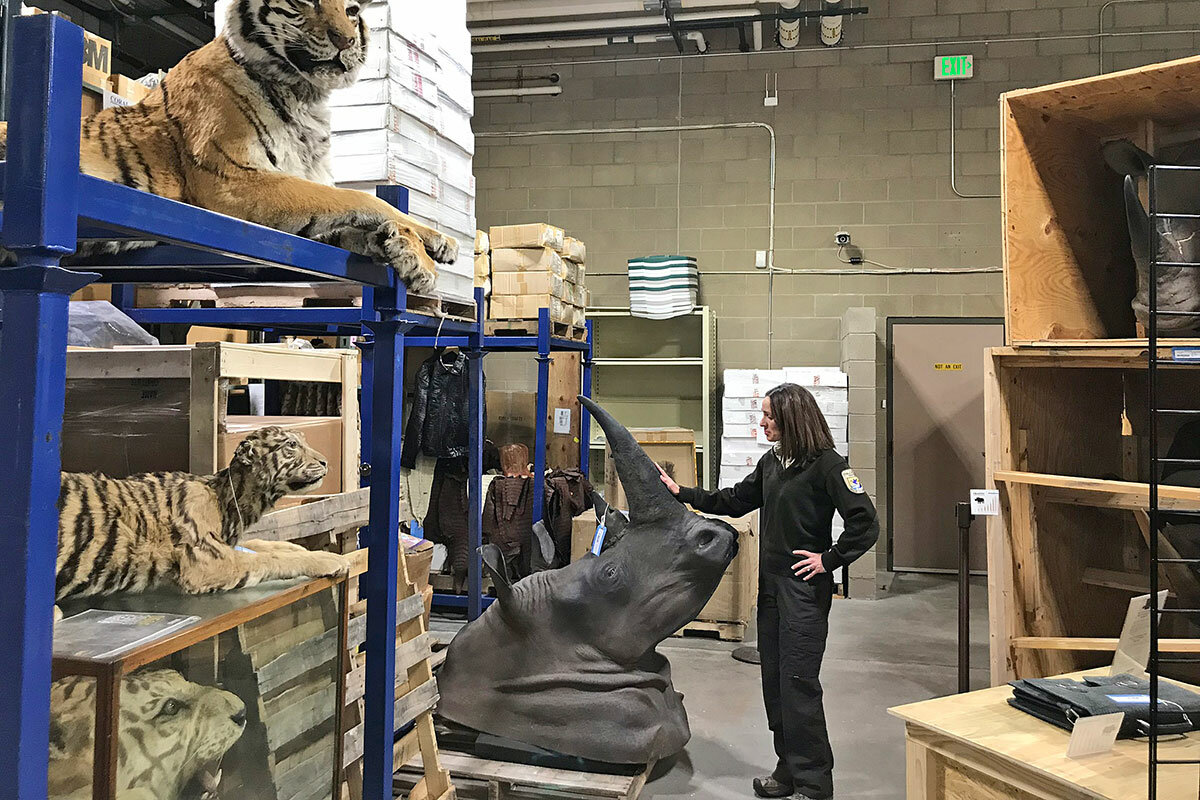How China’s loosening of rhino, tiger ban could spur poaching
Loading...
| Commerce City, Colo.
Tucked away amid the prairies of a wildlife refuge, just a few miles northeast of downtown Denver, sits a nondescript warehouse with a unique – and macabre – collection: 1.3 million illegally trafficked animal parts, from rhino heads and stuffed leopards to bear-foot ashtrays.
Aisle upon aisle of shelves hold items that have been confiscated by officials at points of entry. There are stacks of sea turtle shells and tiger hides; thousands of purses and boots made of reptile skins; one pallet with 35,000 dried seahorses, and an aisle stocked with pills and tonics: dried tiger penises, “seal pills,” pangolin scales, bear gallbladders.
A few of the items are truly bizarre: an embalmed tiger fetus under glass. Toad purses. An ice bucket made from a rhino’s foot.
Why We Wrote This
Some people believe that allowing a limited market for certain species can help curb illegal trafficking. But for rhinos and tigers, as with elephants, the reverse seems to be true.
“You’re going to see value systems that don’t resonate with your own, but the use doesn’t matter. It’s the impact on the species that’s important,” says Sarah Metzer, education specialist at the US Fish and Wildlife Service’s National Wildlife Property Repository. The items at the repository get repurposed for a variety of educational uses, and a visit here underscores one lesson above all: the sheer scale of animal trafficking.
Last week, a surprise announcement from China that it plans to roll back its 25-year ban on rhino and tiger products raised anew a common debate in the world of animal trafficking: whether legal markets encourage or depress their black-market counterparts.
China justified its decision by saying that it will allow only the sale of rhino horns or tiger bones obtained from farmed animals, for use “in qualified hospitals by qualified doctors,” so that “regulation on the sales and use of these products will be strengthened, and any related actions will be authorized, and the trade volume will be strictly controlled.”
But the world largely greeted China’s announcement with dismay. Opening even a limited market for rhino and tiger parts, say observers, will likely fuel demand for those products, increase poaching, and make it harder to crack down on illegally traded items.
“It’s a devastating decision for rhinos and tigers,” says Iris Ho, a senior wildlife specialist at Humane Society International. “It’s akin to a death warrant to these animals in the wild that are already facing myriad threats to their survival.”
China’s announcement may have been spurred by pressure from owners of “tiger farms,” which have grown drastically in recent years and will benefit from the decision. Estimates indicate that the number of captive tigers in China have spiked from about 600 in 2002 to more than 6,000 today, many of them in crowded, poor conditions, says Heather Sohl, the interim Tigers Alive Initiative leader at WWF International.
“Opening up any legal market such as this could allow for the laundering of illegal products that are taken from animals that are poached in the wild,” says Ms. Sohl, noting that there are only about 3,900 tigers left in the wild and about 25,000 rhinos. “There simply aren’t enough animals to have that risk.”
The argument that legal markets can help reduce poaching and black markets surfaces fairly regularly, but – at least with certain species – the evidence tends to show the opposite.
A 2016 study on the effects of legalization of ivory sales on the ivory black market found that the announcement of a one-time legal ivory sale in 2008 corresponded with an abrupt and long-lasting 66 percent increase in elephant poaching across Africa, as well as an increase in smuggling.
No other hypothesis the researchers explored explained the sudden increase, said Nitin Sekar, an ecologist who coauthored the study and now serves as the elephant conservation coordinator for WWF-India, writing in an email.
The study bolstered the claims of those opposed to legalization of ivory, says Dr. Sekar, citing two main effects: The presence of a legal supply makes it less likely that those smuggling illegal goods will be caught, and the availability of a legal supply can increase the demand, driving up both the price and the incentives for poachers.
Advocates of legalization “hope legal trade will undercut the black market,” writes Sekar. “Instead, the legitimization of the good by the government appears to popularize it.”
That’s partly why the world coalesced around an international ivory ban, and praised China when it shut down its ivory market a year ago.
Rhino horns and tiger parts have long been valued by traditional Chinese medicine, though the practice has disavowed use of endangered species in recent years. Powdered rhino horn was prescribed for fevers, and more recently for ailments ranging from hangovers to cancer. Tiger bones are often soaked in wine that’s drunk by those seeking virility, and their pelts can fetch high prices.
With both animals, says Sohl, “it’s very much a wealth symbol now.”
The value of the products has also risen. One rhino horn, which might have sold for $10,000 ten years ago, now might go for more than $500,000 by the time it gets to Asia – a serious incentive to poachers.
More than 7,000 African rhinos have been killed for the illegal wildlife trade in the past 10 years. Tigers are harder to track, because the whole carcass is used. But between 2000 and 2015, parts from 1,755 tigers were seized by law enforcement, according to data from TRAFFIC, a wildlife trade monitoring network. That averages out to more than two tigers killed per week – and those are just the ones that were seized.
While most trafficking experts agree that a ban is necessary, it’s also clear that a ban in itself isn’t enough to stop poaching.
“There are lessons from the ivory experience, but there are also lessons to be gained from the ivory ban,” says Richard Thomas, global communications coordinator for TRAFFIC. The ban was introduced with great fanfare and to wide acclaim, he notes, but market surveys indicate that bans keep only some segments of the population from purchasing ivory. “The real hurdle to making any ban of a product effective is how big is that die-hard segment of society and what can you do to change their attitude toward it.”
On a much smaller scale, Mr. Thomas cites work TRAFFIC did with Amazonian Indians in Ecuador, who were hunting bushmeat at an unsustainable level and selling the meat to visitors in local markets. Working together, community members decided that they needed to stop any hunting that wasn’t for their own consumption and to stop hunting tapirs entirely. The bushmeat markets shut down.
Had a local municipal authority simply banned the hunting, Thomas suspects there would have been a backlash and resentment. “But because you’ve got buy-in across the whole community, it was effective.”
Thomas and others say they’ve been encouraged by the attention that animal trafficking has received in recent years, with a UN resolution to address it passed in 2015 and high-level political buy-in – though it hasn’t yet translated to real poaching reductions on the ground. And there have also been some serious international efforts, including some led by the US, to target the big organized-crime operations that are often behind such trafficking, many of which are often involved in arms, drugs, and human trafficking.
Depending on whether things like illegal fishing and illegal timber are included, species trafficking is anywhere from an $18 billion to $30 billion illegal industry.
Judging by the massive quantities of trafficked items at the repository in Colorado – which represents just a fraction of what is seized at US ports – there’s no quick or easy answer to shutting down such a lucrative trade that still enjoys high demand.
But Ms. Metzer, an educator by training, says that instead of getting depressed by it all, she finds some solace that the items are enjoying a second life, helping to educate children and adults about various species, conservation efforts, and animal trafficking.
“It can be disheartening when you see the quantity and volume that’s here,” she says, “but as odd as this place is, it’s a nexus for allowing people to engage in nature…. I view this warehouse as a conservation success, as strange as that sounds.”








